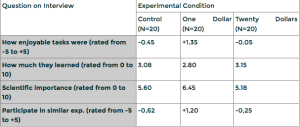Do you ever wonder how we are able to evaluate something and make a final decision? Have you ever mentally convinced yourself of something that in reality is not true? Have you ever seen someone around you do something and convinced yourself that you should do the same thing? We all have at one time or another. And this concept has a title: Cognitive Dissonance. Cognitive Dissonance often occurs due to us comparing ourselves to others and is part of The Social Comparison Theory. According to this article, because there is a “drive within individuals to search for outside images in order to evaluate their own opinions and abilities”. The things we see others do around us we tend evaluate as realistic and as a result, we attempt to obtain these things ourselves.
Null Hypothesis: The people around us have no effect on the decisions we make.
Alternative Hypothesis: The people around us do have an effect on the decisions we make.
A highly influential experiment was performed by Leon Festinger and James Carlsmith which tested this hypothesis. Their experiment was based on 71 male undergraduate students in Introductory Psychology at Stanford University. “Subjects were asked to put spools onto and then off the try with the use of only one hand for half an hour, and then for the next half hour, turn square pegs clockwise in quarter turns, and then start all over again once the whole cycle’s been finished for all 48 square pegs.” These subjects were then divided into two groups: A and B. Group A was not given any information about the tasks they had to perform while Group B was given instructions by a presenter which was in a happy and “enjoyable” tone. “Festinger and Carlsmith then investigated whether there’s a standing evidence of cognitive dissonance where boring tasks were seen as enjoyable.” After this round certain participants were let go. These individuals were viewed to be the control group. The remaining subjects were then offered the opportunity to take the place of the experimenter and give the following group of participants “enjoyable” instructions. Half of the participants given the experimenter job were paid $1 to perform this task while the other half was paid $20.

**only 60 of the 71 participants were included in the final evaluation Source
The result was that “those who were paid $1 were forced to rationalize their own judgments and convinced themselves that what they were doing is enjoyable because they had no other justification. On the other hand, the ones who were paid $20, apparently had the money as their primary justification for carrying out their task.” Festinger and Carlsmith further concluded, based off the the control group, that those who were only paid $1 felt that they were forcing themselves to explain how “enjoyable” of a task this was when in reality it was not. This is a direct result of Cognitive Dissonance. These participants who were paid less felt that they were forced to lie about how they felt due to the fact that the other participants were saying the same thing. “In conclusion, people, when persuaded to lie without being given enough justification, will perform a task by convincing themselves of the falsehood, rather than telling a lie.”
Dr. Jeremy Dean comments on this experiment by stating, “So how can you resolve your view of yourself as an honest person with lying to the next participant? Your mind resolves this conundrum by deciding that actually the study was pretty interesting after all. You are helped to this conclusion by the experimenter who tells you other people also thought the study was pretty interesting.” In other words, the participants’ results have been directly influenced by the other participants’ responses.
Even though this experiment took place in the 50’s it is frequently referred back to and has been published due to its highly successful results. Dr. Dean also states “Since this experiment numerous studies of cognitive dissonance have been carried out and the effect is well-established.”
Conclusion: Due to the abundance of meta analyses which have been performed it is clear that the null hypothesis can be rejected and the alternative hypothesis can be accepted. The additional experiments which were performed, after Festigner and Carlsmith’s, all came to the same conclusion proving the existence of Cognitive Dissonance. There are other aspects of this study which could be looked into more deeply. One of them being that only men were chosen to participate in this study. This could have an effect on the final results. One reason being that it is often assumed women care more about other’s opinions than men. This aspect could be seen as a flaw within Festinger and Carlsmith’s experiment.
Take Home Message: As Dr. Dean states, “Being aware of this can help us avoid falling foul of the most dangerous consequences of cognitive dissonance: believing our own lies.” If we are all more aware of this frequently reoccurring psychological aspect of our lives we could be much more genuine when it comes to making decisions about our own lives.


